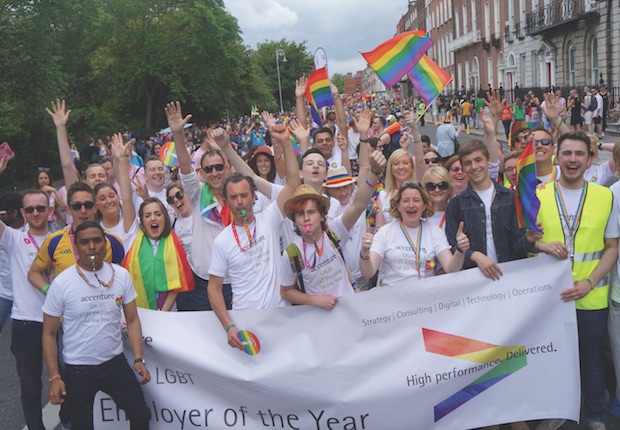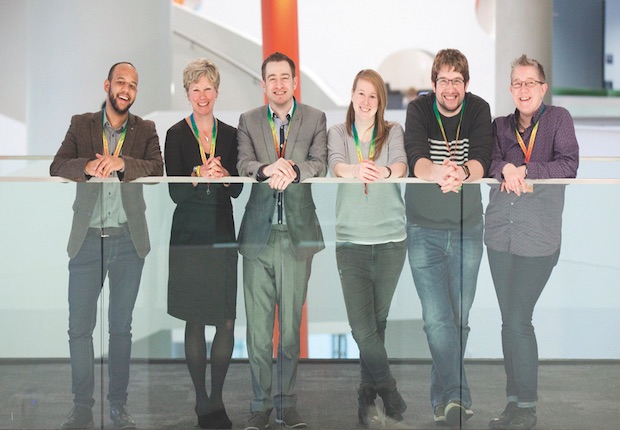
Need to know:
- A supportive working environment can help staff feel they can bring their whole selves to work, benefiting both employees and employers.
- Line managers will be the first port of call for many, so they must feel equipped to offer appropriate support.
- Supportive and flexible workplace benefits should be accompanied by initiatives that embed inclusivity into the culture of the organisation.
In May 2016, it was reported that Lloyds Banking Group would provide employees with access to private gender reassignment surgery through its healthcare scheme, driving support for transgender staff through its employee benefits offering and demonstrating its commitment to being an inclusive employer.
Yet, according to the Employee Benefits/Xerox HR Services Benefits research 2016, published in June 2016, just 24% of respondents view increasing inclusion and diversity as a key issue shaping their benefits strategy this year, falling far behind the desire to improve employee engagement (67%) and to be seen as an employer of choice (61%). It is not a stretch, however, to note that the three are interlinked, and to recognise the positive impact that fostering an inclusive workplace culture can have on engaging and retaining current employees, as well as attracting new talent.
So how can organisations use benefits to enhance inclusivity and diversity? And what other factors should be considered in order to make their use as effective as possible?
Rely on information rather than assumptions
Whether it is identifying hotspots within an organisation where a lack of awareness or support may be serving as a sticking point for inclusivity, such as the retention of female staff following maternity leave, or whether it is building a benefits proposition that supports employees’ diverse requirements, it is important that strategies are based on information rather than assumptions. Rachael Saunders, age at work director at Business in the Community (BITC), says: “[Employers should] make sure that [they] know [their] own data because we all have our own unconscious biases and preconceptions about what the issues might be, so actually asking people and looking at the data [they] hold is the best place to start.”
This includes, of course, listening to employee feedback. Jon Blackburn, clinical and rehabilitation services manager at Aviva, says: “The key is then translating [employee feedback] into a broad spectrum of benefits that meet the requirements of all employees and are not exclusive in any way. Flexible benefits are a great option in that the employee can then select from a broad spectrum of products what suits them most.”
Employers are increasingly recognising the diverse lifestyles, different life stages and priorities among their workforce, and reflecting this in the choice and flexibility built into their benefits programmes. Where possible, going above and beyond minimum requirements can also help organisations to retain talent and ensure that staff are empowered to perform at their best at work. This might include offerings such as enhanced parental leave, emergency eldercare services and resources, or truly flexible ways of working that support major life changes or that enable a new approach to helping older workers transition into retirement.
Organisations can also re-examine their existing benefits to make sure that they are not exclusive in any way. For example, this could include ensuring that the cost structure of certain benefits do not assume a traditional family set-up by offering family rates that cannot be enjoyed by single-parent families and non-traditional family structures, says Siobhan Martin, UK HR director at Mercer. “[Organisations] probably don’t realise that this is an issue until it is looked at from a different lens,” she adds.
Let staff know that support is available
When communicating benefits, being explicit about how they can support all employees can assist in easing any potential concerns that staff may have around take-up. “Inclusive language is really important; [employers shouldn’t] just assume that by the absence of saying something [they’ve] been inclusive,” explains Martin.
This might involve mentioning how healthcare schemes can support transgender staff in relevant pages on the organisation’s intranet or benefits portal, or listing the variety of issues that can be discussed through employee assistance programmes (EAPs) on workplace posters. Employers can also use occasions such as benefits election windows, the launch of new schemes, or relevant awareness and education events to communicate the support that benefits can offer.
EAPs, as well as a number of value-added services offered through healthcare and group risk benefits can help to provide emotional, physical and financial support to staff, but employees must first be aware that such support channels are available and for many that requires signposting from their first port of call: their line manager. Aviva’s Blackburn says: “HR teams are working very hard on producing a broad spectrum of benefits and wellbeing products, but the key may be how a line manager facilitates or delivers those and creates that [inclusive] culture within the organisation.”
Inclusivity and diversity training can help line managers to feel comfortable and confident in supporting their team. Specific training around issues such as workplace stress and mental health can enable managers to spot warning signs and signpost employees to help; although it is worth noting that managers also need support and may benefit from training on how to manage their own mental wellbeing.
The type of training support available to managers may need to evolve to facilitate inclusivity for tomorrow’s workforce. As we live and work for longer, conditions such as Alzheimer’s and dementia may become more prevalent in the workplace. “How many line managers would know what to do if someone came to them following an Alzheimer’s diagnosis?” asks Saunders. “As our demographics change, the types of conversations [managers] need to be taught how to have are changing as well.”
Removing barriers
However, a forward-thinking approach could help affected staff to remain a valued part of the workforce. Claire Williams, director of inclusion and diversity at Inclusive Employers, says: “There are likely to be increasing numbers of people in the workplace who have dementia and employers need to be able to respond to that appropriately. Truly inclusive employers could look at adjustments such as hours of work, or role; it comes back to having that level of flexibility.”
Reasonable adjustments can play a vital role in removing barriers for staff with both visible and non-visible disabilities, as well as for supporting neurodiversity in the workplace. For example, Business Disability Forum’s Square holes for square pegs report, published in March 2016, identifies the working environment, workplace structures and communication as three key areas for consideration in supporting employees with autism. Daniel Wiles, disability consultant at Business Disability Forum, says: “The really important thing that employers and managers can do is make adjustments for people with autism; it’s important to have a process and a policy and also to ensure that line managers have the confidence to do that.”
These adjustments will differ depending on the individual and the barriers they face. For example, this could include adjustments to the physical working environment where the individual is under- or over-sensitive to different sensory stimuli, such as light or noise.
Driving cultural change
Traditionally, organisations have progressed along a path from equality, in terms of compliance with the Equality Act 2010, to diversity, and then towards inclusion, says Becky Brooks, member engagement manager at Employers Network for Equality and Inclusion (ENEI). “[It] can be a diverse organisation but there is no point in having diversity in [the] organisation if it is not inclusive [of that diversity],” she explains.
To create a progressive and inclusive workplace, benefits, processes and support structures must be accompanied by cultural change. Awareness raising and education initiatives can contribute to this, as well as opportunities for staff to help drive the agenda through employee networks or lesbian, gay, bisexual and transgender (LGBT) ally initiatives, for example. Calendar events, such as International Day for Persons with Disabilities or religious celebrations, can also be used to shine a spotlight on particular aspects of inclusivity.
However, the importance of visible leadership cannot be underestimated. Yves Duhaldeborde, senior consultant at Willis Towers Watson, says: “Senior leaders should articulate what greater inclusiveness will do for the business. To sound authentic to employees and managers, [leaders] need to have really built that business case.”
Demonstrations of inclusive behaviours and role modelling among leaders can help staff to see that inclusivity is more than just a hollow tag-line. Although Williams says: “Role modelling is also something that can go all the way through the organisation from the top to the bottom, it’s not just about hierarchy.”
Ultimately, an inclusive and diverse workplace can contribute to employee engagement, wellbeing, and performance, support attraction and retention strategies, and drive commercial advantages in the form of innovation and the development of meaningful products and services that reflect the diversity of consumers. The business case writes itself.
 Accenture embeds diversity and inclusion into its culture
Accenture embeds diversity and inclusion into its culture
Professional services organisation Accenture, which employs just over 12,500 staff in the UK and Ireland, strives to be at the forefront of workplace diversity and inclusivity. Its significant commitment to providing a supportive environment for its employees has received external recognition, such as a 2015 European Diversity Award for Outstanding Employee Network Group of the Year for its African Caribbean Network, and successive recognition as a Star Performer on Stonewall’s Top 100 Employers list.
Tony Horan, UK and Ireland lead for human capital and diversity, says: “We see inclusion and diversity as a real differentiator in terms of our ability to attract the very best talent, to retain the talent that we have, and to really enable our people to be engaged and productive and content in the workplace.”
The organisation embeds inclusivity into its cultural DNA through a range of awareness initiatives, access to online resources, and training opportunities. Inclusivity and diversity training, such as unconscious bias sessions, are offered to ensure managers feel confident and empowered to support their teams, whether that be approving flexible-working requests or signposting staff to a confidential employee helpline, provided by Bupa.
The organisation also runs a wide array of events to celebrate inclusivity and diversity among its workforce. This ranges from activities to mark calendar events such as Pride Week and International Women’s Day, to on-site educational events with external experts, such as a talk from charity Mermaids around how parents can support children with gender identity issues. The inclusivity and diversity agenda also informs Accenture’s corporate social responsibility efforts, for example, staff are given three days’ volunteering leave a year, which can include support for organisations that assist with its inclusivity efforts.
A number of the awareness and education events are available online to facilitate inclusion of employees who work on a remote or flexible basis. Clients are also often invited to attend, enabling Accenture to share its experiences with others and help progress the conversation around diversity issues.
There are a number of employee networks within the organisation, which are encouraged to work together to facilitate support for the whole employee rather than just one aspect of their identity. For example, its family and lesbian, gay, bisexual and transgender (LGBT) network is set to host an event around LGBT fertility. Furthermore, 15% of the organisation’s UK and Ireland employees are LGBT allies, who are actively involved in progressing LGBT support in the workplace, as well as visibly demonstrating their commitment by wearing rainbow-coloured lanyards. There are also 700 mental health allies across all career levels, who have undergone training so that they are equipped to spot early warning signs, signpost staff to support, and open up the conversation about mental health. Plans are in place to increase the number of both LGBT and mental health allies in the organisation.
Accenture is also taking proactive measures to address gender diversity. Horan says: “We’ve taken a holistic approach to gender diversity, so it’s not just looking at maternity integration, it’s also about how we recruit, how we develop women in terms of leadership programmes, how we provide the right sponsorship, the right coaching and the right mentoring. And then it’s also looking at our engagement framework and at some of the offerings that we can make.”
Accenture offers enhanced parental leave of up to 32 weeks on full pay to both mothers and fathers, and offers support to staff before, during and after parental leave to enable them to continue to thrive in the workplace following significant life changes. The organisation also provides various flexible-working options, such as part-time working, job shares, career breaks and study leave. It also continues to look for ways to support gender diversity, for example, its women’s network has become a gender network in order to engage the whole workforce and ensure that gender diversity and equality is a shared agenda with shared accountability.
The organisation underpins its inclusivity efforts with HR analytics, such as analysis of attrition reports or the number of women brought in at different levels through the recruitment process. Horan says: “Keeping front and centre on [diversity and inclusion] from a data perspective enables us to make sure that we can identify areas of concern and make quick interventions before they become problems.”
 University of Sheffield takes proactive steps to enable staff to bring their whole selves to work
University of Sheffield takes proactive steps to enable staff to bring their whole selves to work
The University of Sheffield has worked hard to proactively develop a supportive and inclusive working environment, which has helped to lead to its inclusion on Stonewall’s Top 100 Employers 2016 list, and its ranking in the top third of The Sunday Times’ 100 Best Not-For-Profit Organisations to Work For 2016 list.
In its 2016 staff survey, 94% of employees said they were proud to work for the organisation. Almost all (99%) felt that the university respects staff regardless of their sexual orientation, with high results also reported for other protected characteristics.
Julie Campbell, HR manager, equality and diversity at the University of Sheffield, says: “It’s always about looking at inclusion in the widest possible sense and embedding it into everything we do so that it becomes part of the fabric of the university.”
The organisation’s reward and recognition programme, The Deal, aims to provide an employee benefits offering that has the flexibility and choice required to support the diverse needs of its workforce.
The university also takes a proactive approach to wellbeing in order to support the physical, mental and financial health of all staff. This includes an employee assistance programme (EAP), provided by Health Assured, dignity at work advisors who can provide confidential support to staff and signpost them to appropriate services, occupational health services provided by Health Management Limited, as well as the university’s health and wellbeing programme, Juice, through which staff can get health checks and take part in activities such as tai chi, mindfulness workshops, a staff choir, and bootcamp training.
A number of awareness events around inclusivity and diversity are held at the university, often in partnership with its employee network groups, which include LGBT@TUoS, Women@TUoS, Parents@TUoS, Adopters@TUoS, and the Staff and Disability Network. Working alongside the lesbian, gay, bisexual and transgender (LGBT) network, the organisation set up an LGBT ally initiative this year, Open@TUoS, and almost 700 employees have signed up so far.
Campbell says: “All of our networks run their own social events and also provide a safe space for peer support, but they also align with university business and that’s where we can do some really transformational work and really try to progress the agenda.”
In January, the university hosted its first LGBT Steminar, a day-long event bringing together researchers and academics with the aim of improving LGBT visibility in science, technology, engineering and mathematics (Stem).
To support gender diversity among its workforce, the university offers schemes such as the Women Academic Returner’s Programme. This programme enables female research and academic staff to apply for funds to buy out their teaching or administrative duties, or to put towards a development opportunity, with the aim of helping them stay at the forefront of research in their field following maternity leave.
The university also takes into account the physical working environment when looking at how best to provide an inclusive workplace for employees. In addition to accessibility, this includes considerations such as gender-neutral toilets, prayer rooms, and breastfeeding rooms. Together with the Staff and Disability Network, the organisation runs seminars on inclusive buildings and hidden disabilities. In September 2015, the University of Sheffield launched an app with DisabledGo to provide information about accessibility across its campus.
The app, AccessAble, allows users to locate accessible toilets, lifts, and ramps, get directions around campus, filter results according to their own access requirements. It also includes an emergency locator feature and is compatible with voice software so that it can be accessed by all.
 Viewpoint: Benefits that recognise the diversity of employees’ lives can aid inclusion and engagement
Viewpoint: Benefits that recognise the diversity of employees’ lives can aid inclusion and engagement
The world of work today is very different to even 10 years ago, and so too are employee expectations. Traditional work and home life divides have diminished as a generation grew up connected by and accustomed to sharing their lives on social media. Work and home-life separation has also come under pressure as working parents struggle to achieve work-life balance and instead seek a new ‘work-life blend’.
All this means that employers have had to get better at welcoming the personal side of employees’ lives into the workplace. Those that took up this challenge discovered a new route to improving employee engagement: inclusion.
When someone is able to be their authentic self at work by being open about their sexual orientation, gender identity or mental health, and feels valued and included for who they are, a resilient bond is formed between employee and employer.
Small steps can make a big difference in creating an inclusive workplace. This can be as simple as a leader making a positive statement about mental health in a team meeting. Providing employee benefits that recognise the diversity of employees’ lives is also a very powerful way to communicate an organisation’s stance on inclusion.
Employers, for example, which offer a back-up care service to help when childcare, eldercare or adult care needs break down make a clear statement that they respect and support an employee’s whole life situation. Employers that ensure their private medical scheme meets the needs of transgender employees not only reduce trans employees’ access to treatment by at least 18 months, but confirm their commitment to lesbian, gay, bisexual and transgender inclusion more broadly.
These benefits are used when employees have exhausted other options, meaning the expense for businesses is often not significant. The impact on employee engagement, however, can be material.
Benjamin Fletcher is diversity and inclusion manager at Dentsu Aegis Network